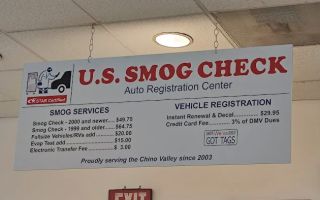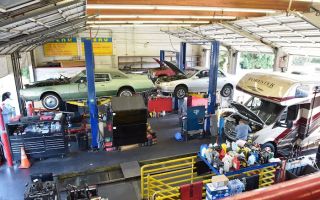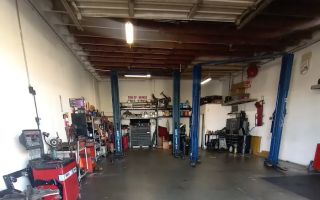Fast Flat Tire Repair on Highways: Quick Solutions and Safety Tips
We’ve all been there—driving down the highway when suddenly, we hear the dreaded sound of a flat tire. It’s not just inconvenient; it’s a real hassle that can cause major delays. If you’re in the middle of nowhere or stuck in heavy traffic, knowing how to quickly fix a flat tire can save you a lot of time and frustration. In this article, I’ll walk you through the steps for fast flat tire repair on highways, share some helpful tips for safety, and explain when to call for professional roadside assistance.

MR. TIRE INC.
2078 New York Ave, Huntington Station, NY 11746, USA
1. Understanding Flat Tires and Common Causes
Flat tires can happen for various reasons, and knowing what causes them can help you prevent them from occurring in the first place. Common causes of flat tires include:
- Road hazards, like nails, glass, or sharp objects on the road
- Potholes or curbs that damage the tire
- Worn-out tires that can no longer hold air
- Improper tire pressure
- Valves that malfunction or are improperly installed
While it’s difficult to avoid all these factors, ensuring that your tires are in good condition and properly inflated before a long drive can minimize the risk of a flat tire. Regular tire checks can make a big difference in your road safety.

MR. TIRE INC.
2078 New York Ave, Huntington Station, NY 11746, USA
2. What to Do First: Safety Measures
Before jumping into fixing a flat tire, the first thing you need to focus on is safety. When you’re on the highway, your safety and the safety of other drivers should be your top priority. Here’s what to do:
2.1 Move to a Safe Location
As soon as you realize you have a flat tire, the first step is to pull over to the side of the road as safely as possible. Ideally, pull into a parking lot, rest area, or another safe location. If you can’t make it that far, make sure you’re as far off the road as possible to avoid traffic. Always put on your hazard lights to alert other drivers.
2.2 Avoid Busy Roads
If you're stuck on a busy highway, you might have to use extra caution when getting out of your car. If possible, wait for traffic to thin out before beginning to work on your tire. It’s important to always be aware of your surroundings and make sure you're visible to passing vehicles.
2.3 Use Your Emergency Kit
Once you're in a safe spot, it’s time to assess your emergency kit. Every driver should have a basic roadside emergency kit in their vehicle, which includes:
- Spare tire
- Car jack
- Lug wrench
- Flashlight
- Gloves
- Tire sealant (optional for temporary fixes)
Having these items on hand will make your flat tire repair much faster and smoother. If you don’t already have an emergency kit, consider putting one together before your next trip.
3. Step-by-Step Guide to Fixing a Flat Tire
Once you're safely pulled over, it’s time to start fixing the flat. Here’s a step-by-step guide to help you repair the tire efficiently:
3.1 Loosen the Lug Nuts
Before lifting the car, use a lug wrench to loosen the lug nuts that hold the flat tire in place. Don’t remove them completely at this point—just loosen them enough so they can be removed once the car is lifted. Remember, it’s important to loosen them while the car is still on the ground to prevent the tire from spinning.
3.2 Lift the Vehicle with the Jack
Place the jack under the car’s jacking point (usually indicated in your car’s owner manual). Slowly lift the vehicle until the flat tire is off the ground. Make sure the jack is positioned on a firm surface to avoid accidents.
3.3 Remove the Flat Tire
Once the car is lifted, remove the loosened lug nuts and then pull off the flat tire. Be careful while handling the tire, as it may be heavy depending on your vehicle’s size.
3.4 Install the Spare Tire
Place the spare tire onto the wheel hub and align it with the lug bolts. Once it’s in place, tighten the lug nuts by hand. You don’t need to tighten them fully at this point—just get them snug enough to hold the tire in place.
3.5 Lower the Car and Tighten the Nuts
Carefully lower the car by releasing the jack. Once the car is back on the ground, use your lug wrench to tighten the lug nuts fully. It’s important to tighten them in a criss-cross pattern to ensure the tire is secured evenly.
3.6 Check the Tire Pressure
Finally, before hitting the road, make sure the spare tire is properly inflated. Check the tire’s air pressure using a gauge, and if necessary, fill it to the recommended pressure level. This will ensure you have a smooth ride until you can get a proper repair or replacement.
4. When to Call for Roadside Assistance
While fixing a flat tire on your own is a useful skill, sometimes it’s best to call for professional help. Here are a few scenarios where you should consider calling roadside assistance:
- If you don’t have a spare tire or the tools to fix it
- If you're in an unsafe location or in heavy traffic
- If the flat tire is caused by more severe damage (like a punctured sidewall)
- If you're unable to remove the lug nuts due to rust or damage
- If you feel uncomfortable handling the repair
Roadside assistance services can be a lifesaver in these situations, and many insurance plans include this as part of their coverage. Be sure to have the number for your service provider readily available in case of emergencies.
5. Preventing Future Flat Tires
The best way to handle a flat tire is to prevent it from happening in the first place. Here are some tips to help you reduce the chances of getting a flat:
- Regularly check your tire pressure to ensure they’re properly inflated.
- Inspect your tires for signs of damage, like cuts or punctures.
- Keep your tires properly rotated and aligned to prevent uneven wear.
- Avoid driving over debris or rough terrain when possible.
- Replace tires that are worn out or have low tread depth.
By staying proactive about tire care, you can minimize the risk of encountering a flat tire during your travels.
Conclusion: Be Prepared for Any Situation
Dealing with a flat tire on the highway can be stressful, but with the right knowledge and preparation, you can handle it confidently. Whether you choose to fix the tire yourself or call for roadside assistance, always prioritize safety first. And remember, carrying a well-equipped emergency kit and knowing how to use it can save you a lot of time and hassle on the road.




























